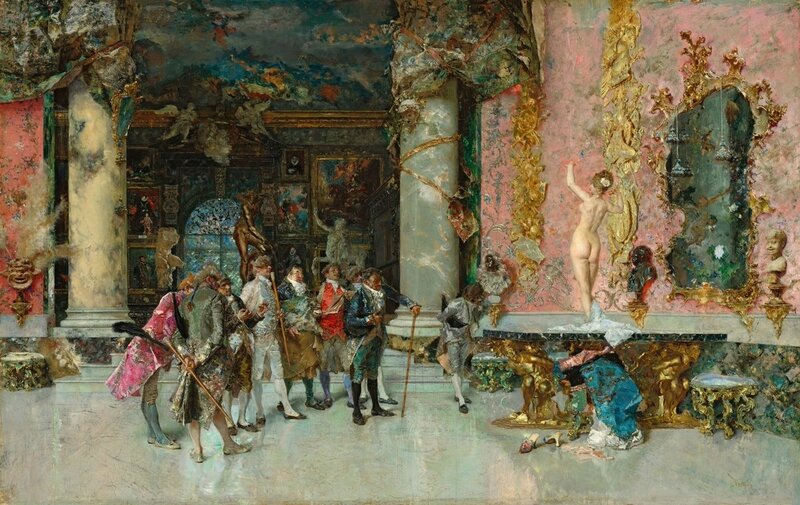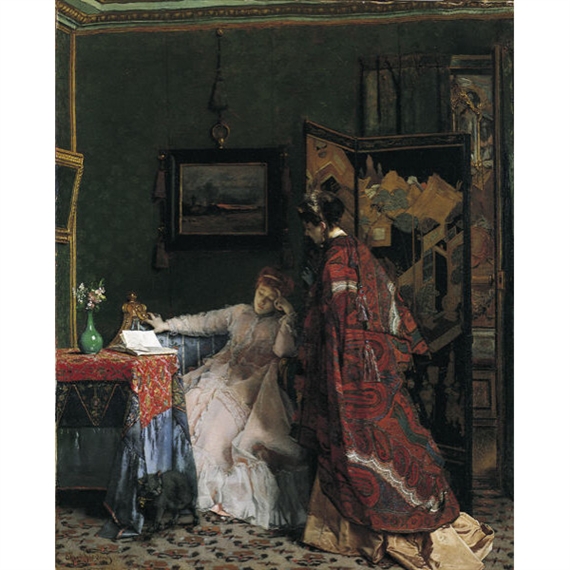Meadows
Museum, SMU
February 3, - June 2, 2019
February 3, - June 2, 2019
This February, the Meadows
Museum, SMU, will examine the far-reaching influence of 19th-century Spanish
painter Mariano Fortuny y Marsal (1838–1874) in the new exhibition Fortuny:
Friends and Followers. During his lifetime and well into the early 20th
century, Fortuny was extremely popular in both Europe and the United States.
His proto-Impressionist style and “exotic” genre scenes influenced so many
artists that the style came to be described with its very own “ism”: “Fortunismo.”
Fortuny: Friends and Followers will explore that legacy by bringing together works from a diverse group of artists, including William Merritt Chase (1849–1916), Jean-Léon Gérôme (1824–1904), Jean Louis Ernest Meissonier (1815–1891), John Singer Sargent (1856–1925), and James Tissot (1836–1902), as well as major works by Fortuny.
With almost 70 works by 23 different artists, the exhibition will address a variety of themes, including intimate representations of family and home, cosmopolitan life in Europe’s major cities at the time, and the connections between and among the artists themselves.

Included in the show are Beach at Portici(1874), the major painting Fortuny was working on at his death, acquired by the Meadows Museum in January 2018,

and The Choice of a Model(1868–74), an important work by the artist on long-term loan from the National Gallery of Art, Washington, D.C.
Also on view will be a number of drawings and illustrated letters from the album compiled by William Hood Stewart (1820–1897), Fortuny’s chief American patron. Also in the Meadows Museum’s collection, The Stewart Album(1860–90) impressionistically records the great American collector’s acquaintance with the Parisian artistic community, and is crucial to understanding Fortuny’s social world.
Much, much more on Fortuny
Fortuny: Friends and Followers is comprised of five thematic sections: “Modern Life and Family”; “The Artist and the Academy”; “A Genre of Nostalgia”; “The Allure of the ‘Exotic’”; and “Cosmopolitan Places.” Together they trace Fortuny’s artistic evolution and the ways he influenced a diverse group of artists, whether by his precise technique or his innovative subject matter.
In the first section, “Modern Life and Family,” the exhibition looks at depictions of domestic scenes that highlight the comforts of contemporary European life. The section’s lead work is the late masterpiece by Fortuny depicting family leisure time, Beach at Portici, which the artist painted beachside near a rented villa south of Naples. The painting, whose creation coincided with the rise of Impressionism, is an example of Fortuny’s experimental, sun-flecked style.

Other works include William Merritt Chase’s Mrs. Chase and Child (I’m Going to See Grandma)(from about 1899)

and The Visit(before 1869) by Alfred Stevens (1823–1906).
All of the paintings in this section take as their subject the intimacy of private life, whether in the home or on a beach holiday.
Drawing on works included in The Stewart Album, the second section, “The Artist and the Academy,” brings viewers into the European artistic community of the 1860s and 1870s through the sketches and illustrated letters of many of its participants.
For example, a sketch by Martín Rico y Ortega (1833–1908) depicts Fortuny painting in a studio alongside some of the artists and collectors in Fortuny’s Parisian circle in 1869. In addition to depicting his friends at work, Rico also included a group of collectors and dealers leaving the studio with their purchases.
The section “A Genre of Nostalgia” tracks the artistic trends of the mid-19th-century, as preferences shifted from large works that addressed major historical or religious themes to smaller, collectible paintings that focused on period costume and lavish interiors. One striking example of this is Fortuny’s painting The Choice of a Model which, with its elaborately staged scene, presents an array of men in ornate costume gazing at a posing nude female. Its Neo-Rococo style, with vibrant colors and extravagant architecture, are key elements of Fortuny’s style at this time.
Fortuny: Friends and Followers will explore that legacy by bringing together works from a diverse group of artists, including William Merritt Chase (1849–1916), Jean-Léon Gérôme (1824–1904), Jean Louis Ernest Meissonier (1815–1891), John Singer Sargent (1856–1925), and James Tissot (1836–1902), as well as major works by Fortuny.
With almost 70 works by 23 different artists, the exhibition will address a variety of themes, including intimate representations of family and home, cosmopolitan life in Europe’s major cities at the time, and the connections between and among the artists themselves.

Included in the show are Beach at Portici(1874), the major painting Fortuny was working on at his death, acquired by the Meadows Museum in January 2018,

and The Choice of a Model(1868–74), an important work by the artist on long-term loan from the National Gallery of Art, Washington, D.C.
Also on view will be a number of drawings and illustrated letters from the album compiled by William Hood Stewart (1820–1897), Fortuny’s chief American patron. Also in the Meadows Museum’s collection, The Stewart Album(1860–90) impressionistically records the great American collector’s acquaintance with the Parisian artistic community, and is crucial to understanding Fortuny’s social world.
Much, much more on Fortuny
Fortuny: Friends and Followers is comprised of five thematic sections: “Modern Life and Family”; “The Artist and the Academy”; “A Genre of Nostalgia”; “The Allure of the ‘Exotic’”; and “Cosmopolitan Places.” Together they trace Fortuny’s artistic evolution and the ways he influenced a diverse group of artists, whether by his precise technique or his innovative subject matter.
In the first section, “Modern Life and Family,” the exhibition looks at depictions of domestic scenes that highlight the comforts of contemporary European life. The section’s lead work is the late masterpiece by Fortuny depicting family leisure time, Beach at Portici, which the artist painted beachside near a rented villa south of Naples. The painting, whose creation coincided with the rise of Impressionism, is an example of Fortuny’s experimental, sun-flecked style.

Other works include William Merritt Chase’s Mrs. Chase and Child (I’m Going to See Grandma)(from about 1899)

and The Visit(before 1869) by Alfred Stevens (1823–1906).
All of the paintings in this section take as their subject the intimacy of private life, whether in the home or on a beach holiday.
Drawing on works included in The Stewart Album, the second section, “The Artist and the Academy,” brings viewers into the European artistic community of the 1860s and 1870s through the sketches and illustrated letters of many of its participants.
For example, a sketch by Martín Rico y Ortega (1833–1908) depicts Fortuny painting in a studio alongside some of the artists and collectors in Fortuny’s Parisian circle in 1869. In addition to depicting his friends at work, Rico also included a group of collectors and dealers leaving the studio with their purchases.
The section “A Genre of Nostalgia” tracks the artistic trends of the mid-19th-century, as preferences shifted from large works that addressed major historical or religious themes to smaller, collectible paintings that focused on period costume and lavish interiors. One striking example of this is Fortuny’s painting The Choice of a Model which, with its elaborately staged scene, presents an array of men in ornate costume gazing at a posing nude female. Its Neo-Rococo style, with vibrant colors and extravagant architecture, are key elements of Fortuny’s style at this time.
Another artist whose work reflects these changes in taste was the Frenchman
Jean Louis Ernest Meissonier (1815–1891).
His
Information (General Desaix and the Peasant)(1867), is an example of this
historicizing approach, which privileges small details—like the exactre-creation
of the uniforms of the Napoleonic soldiers—over the significant event. During
this period, intellectual and artistic communities across Western Europe and in
America found themselves increasingly fascinated by cultures that appeared
foreign in their eyes.
In the section “The Allure of the ‘Exotic,’” the
exhibition addresses this interest in “otherness,” and the growing demand for
art that emulated or depicted these styles and settings. Included are works by
Fortuny, such as a series of etchings that capture scenes and people from his
travels to Morocco,


American painter John Singer Sargent’s watercolor Study for “The Spanish Dancer”(1882), demonstrates United States audiences’ tastes for the flamenco music of Spain.

Mariano Fortuny y Marsal (Spanish, 1838–1874), Crouched Arab, c. 1871. Oil on panel, 3.5 x 5 in. (9 x 13 cm). Meadows Museum, SMU, Dallas. Museum purchase with funds donated by Jenny and Richard Mullen and friends of the Meadows Museum, MM.2018.09. Photo by Kevin Todora.and an oil study, Crouching Arab(Meadows Museum), that he executed in preparation for the figure in a larger painting.

American painter John Singer Sargent’s watercolor Study for “The Spanish Dancer”(1882), demonstrates United States audiences’ tastes for the flamenco music of Spain.
Also presented
in this section is the work of Jean-Léon Gérôme, whose works

Turkish “Bashi-bazouk” Mercenary Soldiers Playing Chess(about 1870–73)

and Tiger on the Watch(about 1888), demonstrate his skill at presenting these so-named Oriental scenes.

Turkish “Bashi-bazouk” Mercenary Soldiers Playing Chess(about 1870–73)

and Tiger on the Watch(about 1888), demonstrate his skill at presenting these so-named Oriental scenes.
The
exhibition concludes with the section “Cosmopolitan Places,” which illustrates many
of the sites and people that Fortuny and his artistic followers recorded in their
art throughout their travels in Europe. Wherever these itinerant artists lived
or worked, whether in grand apartments on the Avenue des Champs-Élysées in
Paris, along the canals of Venice, or near the seashore in Portici, they sought
to document and interpret the world around them through their art.

For example, A Lady at the Paris Exposition(1889), painted by Luis Jiménez Aranda (1845–1928), is emblematic of the French capital’s importance to the art world,

while Martín Rico’s Rio San Trovaso, Venice(1903) captures another city beloved of artists and collectors.

For example, A Lady at the Paris Exposition(1889), painted by Luis Jiménez Aranda (1845–1928), is emblematic of the French capital’s importance to the art world,

while Martín Rico’s Rio San Trovaso, Venice(1903) captures another city beloved of artists and collectors.
Meadows Museum Curator Amanda W. Dotseth added,
“Today Fortuny is not a household name, but his popularity and influence in the 1860s and early 1870s cannot be overstated. He was one of thebest-selling artists of his time and lived a cosmopolitan lifestyle that seamlessly blended work with leisure. He traveled frequently between southern Spain, Paris, Rome, Naples, and Venice with an impressive entourage of friends and followers in tow. And, although he died at only thirty-six years old, his legacy long survived him through his works, which would inspire later generations of artists, from Vincent van Gogh to Dalí and Picasso.”
Fortuny: Friends and Followers has been
organized by the Meadows Museum and is funded by a generous gift from the
Meadows Foundation.
The exhibition is made possible thanks to loans from a
number of museums in the United States, including: Dallas Museum of Art; Museum
of Fine Arts, Houston; National Gallery of Art, Washington, D.C.; New Orleans
Museum of Art; San Antonio Museum of Art; as well as the Leva-Laves Collection
and several private collections.
The exhibition will be accompanied by a
catalogue, co-edited by Roglán and Dotseth, that recreates the exhibition’s five
sections with full-color reproductions of the exhibited works and thematic
introductions by Dotseth. These support an art historical essay by Meadows Curatorial
Fellow Daniel Ralston, who locates Fortuny’s life and work within the artist’s milieu
and explores his lasting impact on both his contemporaries and later
generations of artists. The publication concludes with short biographies of
each artist featured within the exhibition.